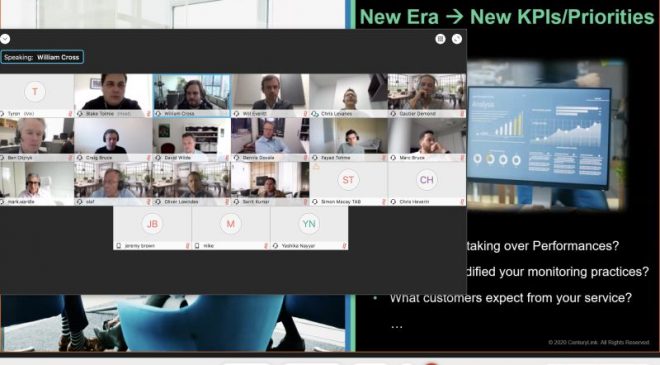
CenturyLink is now Lumen Technologies
Sponsored content: Thursday, 10th September 2020 – Australia, New Zealand and Singapore
Focus Network, in partnership with Lumen (formerly CenturyLink), brought together leading executives from media, entertainment and education high-profile brands to discuss important Industry topics of:
- Increasing business flexibility in uncertain times
- Best practices for improving content delivery experiences with new technologies
- Protecting your core – content and intellectual property (IP)
The session was coordinated by Tyron McGurgan and Blake Tolmie from Focus Network, and providing expert insights to the discussion were experienced thought leaders – Chris Levanes and Gautier Demond.
Brief introduction of the speakers
Chris Levanes, Director of Solutions Marketing and BizOps, Lumen Asia Pacific is based Singapore, and his team is responsible for driving Solutions Marketing, Pricing Strategy, Product Program Management and BizOps initiatives across Lumen’s Adaptive Networking, IT Agility and Connected Security and Media & Content businesses.
Gautier Demond, Director, Content & Media Practice, Lumen Asia Pacific started working in the video streaming industry in 2003 for Nintendo to set-up their video encoding department, and currently leads the regional Content & Media product strategy, P&L and roadmap for Lumen’s portfolio of CDN, CDN Mesh, CDN Edge & Vyvx products.
Reset in 2021 – Post COVID evolution of business KPIs
One of the key objectives of this roundtable was to discuss the significant disruptions that have impacted businesses in recent times. Chris Levanes began the discussion by “reflecting upon the representative content delivery KPIs formany organisations last year. These KPIs likely included revenue growth, improving customer experience, mitigating security issues, improving performance of SaaS applications, achieving cost savings, to name a few. However early into this calendar year, many of the KPIs for most organisations abruptly changed due to the impact of COVID-19. Some were de-prioritised, whereas others became more prominent, in which to help mitigate or capitalise upon the macro conditions occurring from the pandemic”.
For example, Industry data was shared with the attendees that showed an exponential increase in content streaming and delivery demands across video streaming and social media platforms, as a direct consequence from the stay-at-home orders that were put in place around the globe. Similarly, user consumption behaviours also showed significantly variations to pre-COVID patterns due to the new work and social circumstances.
“Another area that COVID had a sizeable and unanticipated impact was that many governments had to mandate or negotiate with streaming and gaming providers to help reduce network congestion that was occurring in many countries”, noted Levanes. Specific to Australia, there were sessions conducted by the Australian Federal Communications Minister with the top streaming providers in which he asked them to reduce their bitrates, and similarly approached the gaming industry and asked them to volunteer ways to reduce their load upon the broadband network. Likewise, Government directives occurred in other countries – New Zealand, US, and Europe – were shared as examples.
It was also discussed that the increased consumption of content had a corresponding negative influence upon the relationships between CDN peering partners, content providers and ISPs (internet service providers). This tension arose from the conflicting pressures to service their respective customers, including last-mile congestion stemming from many people working from home or furloughed, and was exacerbated by the need to guarantee access to what was now deemed to be essential services. Furthermore, the demand was creating considerable equipment and network fatigue, as well as pressures upon support teams, and in the event of a hardware failure, COVID-19 made it very challenging to conduct on-premise maintenance due to the movement restrictions that were in place. All of these factors resulted in an unusual prevalence of Cloud, CDN and network outages, for services which were previously considered relatively reliable.
Discussion topic – How to rapidly evolve to the new era
The roundtable attendees then shared insights on how their organisations had adapted to the new landscape.
“One of the things for us is the opportunity to increase our audience at the rate of change and kinds of behaviour [changes] that the pandemic has caused”, says Will Everitt, Director, Product Solutions, Seven West Media. “I was on a call with ITV a couple of weeks ago and one thing they had noticed was changes in behaviour for certain demographics. Linear TV viewers of a certain demographic have shifted now to streaming in Europe and UK. Their major concern is that, those viewers won’t be coming back. That means, there needs to be more emphasis or focus on streaming for us as a video company as well. This was from a domestic market perspective, so the focus is to be able to scale within this kind of a market.”
“A lot of what we do is advertising support and VOD (video on demand), we don’t sell anything directly to our viewers”, shared Will Cross, Head of Digital Operations & Support, Seven West Media. “We saw a huge increase in the number of people coming to our service. We were already trending up steadily, but it was a very noticeable spike which then have implications on things like CDN and the actual cost of delivering that content. But what has also happened in the market, especially in the advertising support markets, is that the total pool of advertising revenue across the industries dropped as a lot of companies who are in a cost saving mode aren’t spending much on advertising and marketing. This has put us in this interesting situation where we are thinking outside the box on how we are going to service more consumers than ever before in a way that our base cost of delivering those services are reduced. Things like looking at the level of bitrate at which to deliver content serves two purposes; appeasing the request of the regulatory bodies who want us to do our part in reducing congestion on the networks whilst also in the same token bring the cost of delivery down. So, it was more about how to make the delivery of our service more efficient so we can maintain that uptime, and that has been the biggest journey we have undertaken in the last few months and it has been an interesting one.”
“We are an audio business and we stream radio and podcasts and with COVID we had an immediate shift of people’s consumption patterns. While they used to consume audio during their commute via the FM podcast, and now that people don’t have radios at home, we have seen a shift to ‘smart speak’ via Alexa or Google Home and 25% of all of our streaming came via smart speakers”, says Fayad Tohme, Chief Digital Officer Nova Entertainment. “Behaviours and consumption changed dramatically, and we shifted from an FM broadcast to an internet service. So, internet became a core channel when people are in lockdown. We had to drive that awareness and make sure, not from just an operations perspective to ensure stability but also from a marketing or promotional perspective to make sure people know where to consume. That education piece was core for us and also reporting back to the market around these consumptions and stability.”
“Our key business area is teaching and learning and that was hugely impacted. One of the things that we pride ourselves on is the teaching experience on campus and with the onslaught of COVID, we had to change our priorities and investments and focus on remote teaching and remote learning options”, said Sanit Kumar, Infrastructure Services Portfolio Manager – Cloud, Network & Datacentre Services University of Auckland. “There was also a cultural change element because some of the academia were not used to teaching remotely. So that change element was significant where they were well supported to manage those new ways of teaching and creating content around online teaching and services offered by the University. As far as the content delivery is concerned, there was an actual reduction in internet traffic on campus from a local consumption perspective but then we saw a huge traffic increase in our digital learning platform which we were already in the process of modernising pre-COVID. We also had challenges with students stuck overseas and we managed to do some workarounds to get them onboarded digitally to get the similar experience that they used to have on campus.”
Gautier Demond shared a vendor’s perspective by saying “from a Telco and CDN standpoint, our business has also been notably impacted. At the beginning of the year, every CDN service provider was focussing on similar topics of performance, cost optimisation, the ability to unlock features and expansion within the country. But when we started observing the pandemic trends and seeing massive spikes in traffic, we made some substantial adjustments. One immediate focus was upon hardening our network and services to cater for the intensified traffic. We also began to segregate customers based upon whether they were now classified as an ‘essential services’ or how ‘spikey’ was their traffic. Our objective was to create zones of relative stable traffic which was easy to manage, and then dedicate other resources to customers with extremely spikey traffic to ensure we were better positioned to respond to unprecedented volumes or unplanned events. We also modified our collaboration with ISPs by having daily conversations with them, to garner insights on external events such as press conferences, release updates from gaming companies, etc with the view of anticipating high volume days and times.”
Discussion topic – Drive towards business agility
Having responded to the immediacy of the COVID crisis, many organisations are now seeking to improve their business agility, to continue to cater for the ongoing uncertainty of the pandemic, as well as set themselves up for the ‘next normal’ future landscape. For many organisations, this involves considerations of embarking upon a multi-CDN vendor strategy, as well as a desire to negotiate more flexible commercial agreement structures. The discussions below represent the attendees thoughts and issues on this topic.
“We are in a unique position as we are a publisher, Telco and a CDN. In terms of growth, what we are seeing is just a trend upwards and if anything, just an acceleration of that growth has happened as a result of COVID”, stated Jeremy Brown, Associate Director Video Delivery, Optus Sport. “We needed a multi-CDN strategy to create those redundancies that are very important not just on our outgoing CDN but through our origins and other parts of the network. And looking at shielding those products is very important to our strategy. With sport, we deliver huge amount of traffic in HD and high concurrency. QoS (quality of service) is a very important metric and there are a couple of really good players in the market, who create nice dashboards so we can monitor how we are performing.”
“We have seen that same increase or uptake in usage during COVD-19 as the others have reported”, says Craig Bruce, Head of Engineering – 9Now, Nine Network. “We have had some internal discussions going on regarding the viability of multi-CDN. We are a localised service within Australia, and we haven’t had huge issues from the CDN side of things. By and large we are quite predictable in our traffic with shows and events, current affairs and news content especially in the early part of the lockdown period. We are exploring on how to improve our service to end users for sure.”
“We are a business with streaming content, with streaming live racing across the country and we also run a live betting platform. When COVID first hit, we had to move all of our production remotely as also all of our tech teams”, notes Simon Mackay, Head of Technology, TAB New Zealand. “During the Melbourne Cup, we anticipate loads bigger than rest of the year, so we had to build a network that would withstand huge loads. As an example, we do about 1 million transactions just in race 7 of the Melbourne Cup over a 15-20-minute period. With regards to multi-vendor strategy, COVID hit us very hard, and we had to lean on our vendors very heavily to give us rebates from a long-term relationship point of view. The catch with having multi-vendors is that you dilute that ability to have a strong vendor who can hold you up when the revenues are not coming in. As much as we would like to have multiple vendors to create a bit of competitive tension, it’s also good when you have a vendor that has a good long-term relationship with you and that stood us well.”
Dennis Dovale, Manager, Media Technology, Tabcorp / Sky Racing mentioned, “what makes this year very different from last year is that our current traffic flows were higher than the Melbourne Cup last year and that’s because most of our venues are down and hence people are not in the venues and are using the digital platform. We are planning a 100% increase in traffic this year for Melbourne Cup through our CDN which is a big thing for us. The multi-CDN approach is great but we have the same problems of commitment with the current CDN and the amount of money we have to spend to have that in place, unless there is a new process within CDNs where we can talk about consumption model.”
“We have seen a huge change in traffic patterns over this COVID period from over 2 Million students learning on-campus to suddenly everybody moving home and connecting via Optus and TPG etc, and expect that to remain the same for a foreseeable time”, described David Wilde, Chief Technology Officer, AARNET. “The question of resilience, capacity and scaling are some lessons that came out of this experience. For the higher-ed sector, that ability to shift to learning from home is a completely different practice through a lot of the universities. Many of the regional universities have done that for a long time already, delivering online courses of various sorts. But for a lot of the bigger universities, the structure was built around students coming into lecture theatres. One interesting thing in our sector is that sometimes a DDoS [attack] is indistinguishable from a perfectly legitimate research work. So, a researcher who is pulling down 50gbs per second from the Hadron Collider or an astronomy telescope, looks a lot like DDoS, so we always have a practice around dealing with strange behaviours on the network compared to lock stock traffic that is legitimate or when it’s not.”
Levanes shared that, “in addition to DDoS, the number of security attacks has risen quite significantly during the pandemic. For example, people’s thirst for more knowledge around the COVID virus has been leveraged by hackers to unleash phishing scams to obtain user credentials in which to begin attacks upon Corporate resources. Hence an integrated approach to security is becoming extremely important.”
Demond also contributed to the topic by saying, “I concur with the views that up until recent times, the big value of having a single source approach is that you can negotiate a good rate with volume purchase buying power. But what we are hearing from our customs is that the increase risk of global outages and demands in the new normal has placed more influence on the business to consider the benefits of a multi-vendor approach and redundancies, because the cost savings don’t necessarily outweigh the business impact of any outages. Furthermore, when talking about multi-CDN, which is not new and has been around for a few years now, there has also been the notion of moving away from mandatory commitments. Probably one of the most common requests coming from our customers, is their desire to engage on a usage-based model, which we can support.”
Discussion topic 3 – Return to innovation
The conversation also touched upon the emergence of new technologies, including: mesh delivery, the return of multicast, cloud edge computing, and new adaptive ecosystems where the entire video processing ecosystem adapts based on the demand or the network conditions. The participants discussed their challenges and investments in new technologies and business innovations.
Wilde shared that “automation and analytics is very important now in the higher-ed sector as things are going to be lean for some time. If you look at the billions of dollars that have been disappearing in terms of revenue, that’s not going to come back straight away, and the sector will be hurting for years. Therefore, the ability to be smarter about how we deliver services and how we support traffic is going to be key to the next couple of years.”
“With SD-WAN and the ability of the network to adapt to your current consumption, or the current needs of the customers, we are starting to see that pattern and continue to work on how we can apply that to the delivery and video process. The network defined video processing chain is definitely some of the things we are looking at from a Lumen standpoint”, says Demond.
Mark Wardle, VP Engineering & Operations, APAC, Encompass Digital Media says “We are talking to a lot of our vendors about operating cost models more than capital expenditure models so if channels or concepts want to pop up real quickly, higher speed to market and a flexible cost base is a key feature for us rather than having to invest a lot of Capex upfront requiring long commitments.”
Lumen CDN is focussed on delivering fast, secure, and reliable delivery and are experts in:
- Video delivery: Lumen solutions for video on demand (VOD) and live linear internet video channels (alternatively, over-the-top video) combine the advantages of our proven, global Origin Storage Platform with our broadcast video services to deliver video to end users quickly, securely and reliably.
- Digital downloads: End users expect quick, secure and reliable updates. Our Digital Download service enables you to seamlessly deliver your files, security patches, apps and more to an increasingly connected world.
- Web delivery: Lumen Website Acceleration services help transform your website by optimizing performance at the network, code, delivery, and browser levels to get content virtually wherever it needs to be at lightning speed.
This brought to conclusion a highly interactive session with participation from the delegates and great discussions facilitated by Lumen. Focus Network facilitates a data-driven information hub for senior-level executives to leverage their learnings from, while at the same time assisting businesses in connecting with the most relevant partners to frame new relationships. With a cohort of knowledge-hungry and growth-minded delegates, these sessions impart great value for participants. With the advent of the new ways of working remotely, Focus Network continues to collaborate with the best thought leaders from the industry to still come together to share and navigate the ever-changing landscapes that’s barrelling into the neo industrial revolution.
Tags: Business AgilityCDNCenturyLinkCloud ServiceslumenNetworks




